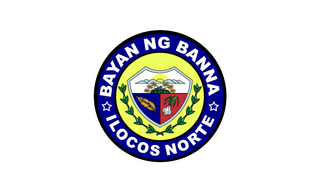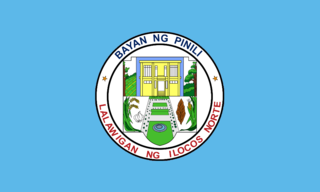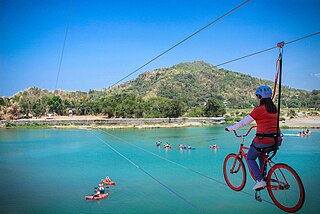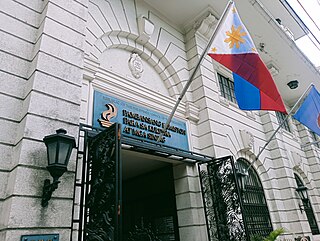Related Research Articles

Ilocos Norte, officially the Province of Ilocos Norte, is a province of the Philippines located in the Ilocos Region. It is located in the northwest corner of Luzon Island, bordering Cagayan and Apayao to the east, and Abra to the southeast, and Ilocos Sur to the southwest. Ilocos Norte faces the South China Sea to the west and the Luzon Strait to the north. Its capital is Laoag City, which is the most populous in the province.

The Ilocos Region, designated as Region I, is an administrative region of the Philippines. Located in the northwestern section of Luzon, it is bordered by the Cordillera Administrative Region to the east, the Cagayan Valley to the northeast and southeast, Central Luzon to the south, and the South China Sea to the west.

Banna, officially the Municipality of Banna, is a 4th class municipality in the province of Ilocos Norte, Philippines. According to the 2020 census, it has a population of 19,297 people.

Pinili, officially the Municipality of Pinili, is a 3rd class municipality in the province of Ilocos Norte, Philippines. According to the 2020 census, it has a population of 17,626 people.

Vintar, officially the Municipality of Vintar, is a 1st class municipality in the province of Ilocos Norte, Philippines. According to the 2020 census, it has a population of 33,339 people.
Ilocano literature or Iloko literature pertains to the literary works of writers of Ilocano ancestry regardless of the language used - be it Ilocano, English, Spanish or other foreign and Philippine languages. For writers of the Ilocano language, the terms "Iloko" and "Ilocano" are different. Arbitrarily, "Iloko" is the language while "Ilocano" refers to the people or the ethnicity of the people who speak the Iloko language. This distinction of terms however is impractical since a lot of native Ilocanos interchange them practically.

The Ilocanos, also referred to as Ilokano or Iloko, are an Austronesian ethnic group and the third-largest ethnolinguistic group in the Philippines. Originally from the Ilocos Region on the northwestern coast of Luzon, Philippines and later expanded throughout Northern Luzon. Their native language is called Iloco.

The National Commission for Culture and the Arts of the Philippines is the official government agency for culture in the Philippines. It is the overall policy making body, coordinating, and grants giving agency for the preservation, development and promotion of Philippine arts and culture; an executing agency for the policies it formulates; and task to administering the National Endowment Fund for Culture and the Arts (NEFCA) – fund exclusively for the implementation of culture and arts programs and projects.

Basi is a native Ilocano fermented alcoholic beverage or wine made with sugarcane juice, particularly those produced in Northern Luzon particularly in Ilocos Region. This wine is processed in "burnay" or "tapayan".

The National Living Treasures Award, alternatively known as the Gawad sa Manlilikha ng Bayan, is conferred to a person or group of artists recognized by the Government of the Philippines for their contributions to the country's intangible cultural heritage. A recipient of the award, a National Living Treasure or Manlilikha ng Bayan is "a Filipino citizen or group of Filipino citizens engaged in any traditional art uniquely Filipino, whose distinctive skills have reached such a high level of technical and artistic excellence and have been passed on to and widely practiced by the present generations in their community with the same degree of technical and artistic competence."
Intangible cultural heritage (ICH) includes traditions and living expressions that are passed down from generation to generation within a particular community.

Iloco is an Austronesian language predominantly spoken in the Philippines by the Ilocano people. It ranks as the third most widely spoken native language in the country and serves as a lingua franca in Northern Luzon, particularly among the Igorot people and the indigenous settlers of Cagayan Valley.

Magdalena Gamayo is a Filipino weaver who is a lead-practitioner of the Ilocano tradition of pinagabel.

Abina Tawide Coguit is a Filipino textile master weaver
Hadja Sakinur-ain Mugong Delasas is a Filipino folk dancer who specialize in the Sama dance of Igal.
Marife Ravidas Ganahon is a Filipino mat weaver known for the Higa-onon Manobo mat weaving art of ikam.
Amparo Balansi Mabanag is a Filipino beadworker and embroider.

Samporonia Pagsac Madanlo is a Filipino artisan known for the dagmay weaving.
Barbara Kibed Ofong is a Filipino master textile weaver who specialize in T'nalak.
Rosie Godwino Sula is a Filipino chanter, musician, composer, and dancer.
References
- ↑ "Today we celebrate the 78th Birthday of Manlilikha ng Bayan Adelita Bagcal". Instagram (in Filipino and English). National Commission for Culture and the Arts. Archived from the original on November 15, 2024. Retrieved January 16, 2024.
- ↑ Mugas, John Michael (December 23, 2023). "Ilocano Adelita Bagcal, Manlilikha ng Bayan for 2023, hailed as 'cultural bearer'". Rappler. Archived from the original on December 23, 2023. Retrieved November 15, 2024.
- 1 2 3 4 Adriano, Leilanie (December 22, 2023). "'Dallot' Queen: Preserving Ilokano oral traditions". Philippine News Agency. Retrieved November 15, 2024.
- ↑ Cabie, Honor Blanco (December 31, 2023). "Ilokandia's second National Living Treasure". Manila Standard. Retrieved November 15, 2024.
- ↑ Manuel, Elmer Navarro (December 25, 2023). "Ilokano oral traditions remain alive". Daily Tribune. Retrieved November 15, 2024.